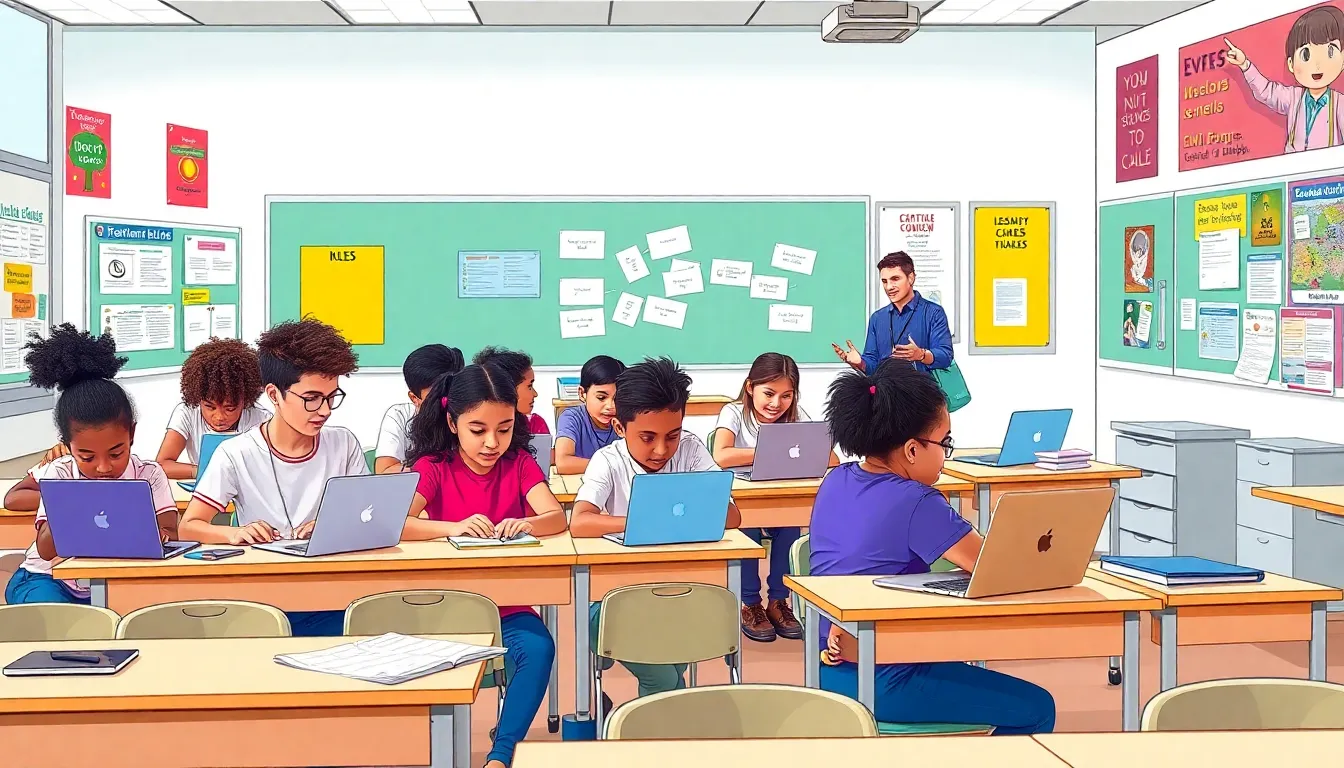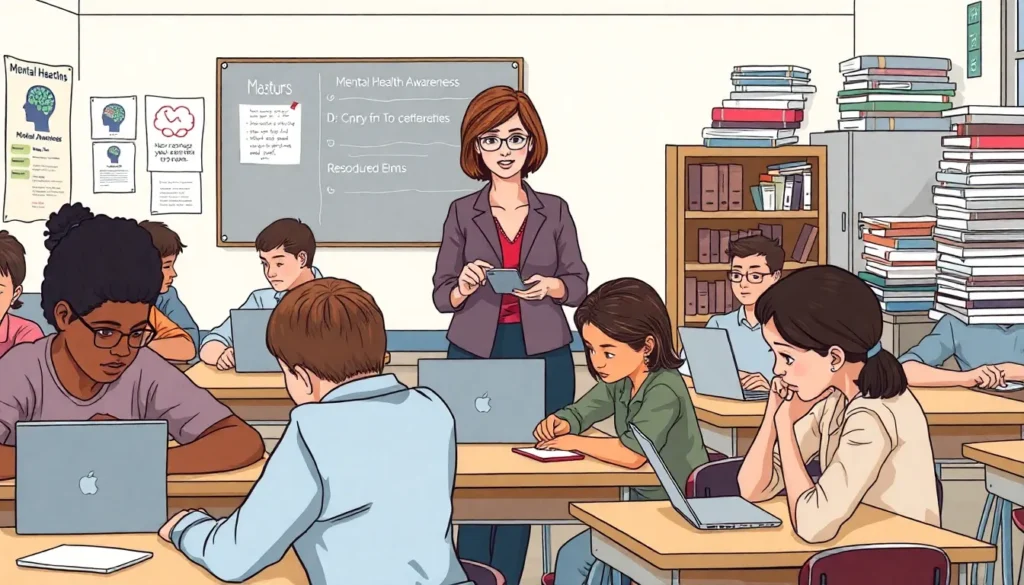Table of Contents
ToggleSchools today face a wild mix of challenges that could make even the most seasoned educators pull their hair out. From outdated textbooks to tech-savvy students who think “homework” is a mythical creature, the landscape of education is shifting faster than a kid dodging a pop quiz. It’s a chaotic blend of social issues, mental health concerns, and the ever-looming threat of budget cuts that leaves many wondering if they’ve accidentally stepped into a sitcom rather than a classroom.
As teachers juggle the demands of curriculum and classroom management, they also navigate the minefield of student well-being and engagement. With distractions lurking around every corner—hello, smartphones!—the quest for effective learning feels like trying to catch confetti in a windstorm. Understanding these problems is crucial not just for educators but for parents and policymakers who want to help shape a brighter future for the next generation.
Overview of Problems in Schools Today
Schools face a range of pressing challenges that affect both students and educators. Outdated resources often hinder effective learning. Insufficient access to technology creates disparities among tech-savvy students. Social and mental health concerns impact student engagement and academic performance significantly.
Teachers encounter difficulties in balancing curriculum demands with the need for student well-being. The presence of distractions, especially smartphones, complicates efforts to maintain focus in the classroom. Mental health issues among students have seen a marked increase, demanding more attention from educators and support staff. Bullying also remains a critical issue, affecting not only the victims but the overall school environment.
In addition to these concerns, funding limitations lead to overcrowded classrooms and reduced extracurricular opportunities. Insufficient training in emerging educational technologies leaves some teachers unprepared to address the needs of their students. Many schools struggle with retaining qualified staff, resulting in high turnover rates that disrupt continuity in education.
Schools today must also navigate complex societal issues, including economic inequality and varying family structures that impact student experiences. Policymakers, educators, and parents play vital roles in addressing these interconnected issues, ensuring that every student has the opportunity to succeed. Understanding these problems is essential for creating effective solutions that enhance the educational landscape.
Academic Challenges

Schools today face significant academic challenges that hinder student success and overall learning experiences. From testing formats to curriculum relevancy, these issues demand close examination.
Standardized Testing Issues
Standardized testing impacts student learning and evaluation. Critics argue that these tests promote a narrow focus on test-related content, which neglects a broader understanding of a subject. Teachers often feel pressured to teach to the test, which limits creativity and critical thinking in the classroom. Performance anxiety can cause further stress among students, leading to lower scores. Additionally, disparities in test resources can disproportionately affect students from lower-income families, perpetuating educational inequality.
Curriculum Relevance
Curriculum relevance poses a challenge in engaging today’s students. Many educational programs fail to connect course material with real-world applications, resulting in diminished interest. Students today possess diverse interests driven by technological advances and changes in societal needs. An inflexible curriculum can alienate learners, making them less likely to retain information. Updating curricula to include relevant skills—such as digital literacy and problem-solving—is crucial for preparing students for future job markets. Adjusting course content ensures that schools address the needs of a rapidly evolving society.
Social and Emotional Concerns
Social and emotional issues significantly affect school environments today. They lead to various challenges for students and educators alike.
Bullying and Its Impact
Bullying remains a critical concern within many schools, often manifesting as physical, verbal, or cyber forms. Victims frequently experience long-term emotional distress, low self-esteem, and academic decline. Studies indicate that about 20% of students report being bullied, impacting the overall school climate. Teachers face challenges addressing bullying, as they must navigate complex social dynamics while fostering a safe environment. Schools that implement anti-bullying programs often see positive changes, such as improved student morale and engagement.
Mental Health Awareness
Mental health awareness has gained traction but still lags in many educational settings. A survey found that nearly 50% of high school students reported feeling persistently sad or hopeless. Limited resources hinder schools from adequately addressing these mental health concerns, which can lead to decreased academic performance. Investing in mental health resources and support programs correlates with improved student outcomes. Educators require training to recognize signs of mental health issues and access appropriate resources to assist students effectively.
Resource Limitations
Resource limitations impact schools significantly, affecting student outcomes and overall educational quality. Funding constraints and teacher shortages contribute to ongoing challenges within the system.
Funding Shortfalls
Funding shortfalls hinder schools’ ability to provide essential resources. Equipment like updated textbooks and technology often remains out of reach. Programs designed to enhance academic opportunities face cuts, limiting extracurricular activities. Approximately 20% of schools report a lack of sufficient funds to meet basic needs. Class sizes grow, making it difficult for teachers to give individualized attention. Schools continually seek grants and alternative funding sources, but these efforts often fall short. Effective resource allocation is critical for fostering an engaging learning environment.
Teacher Shortages
Teacher shortages exacerbate existing educational challenges. Many schools struggle to fill positions, especially in critical subject areas such as math and science. The shortage of qualified educators leads to overcrowded classrooms and less effective instruction. Schools face increased turnover rates, further destabilizing student learning. Research indicates that schools with high turnover experience lower student achievement. To attract and retain teachers, schools must offer competitive salaries and professional development opportunities. Failing to address these shortages jeopardizes educational quality and limits student success.
Technology Integration
Schools face significant challenges in effectively integrating technology into the learning environment. By understanding these issues, educators can enhance student engagement and academic performance.
Digital Divide
A clear disparity exists in technology access among students. About 20% of students lack reliable internet access, which hampers their ability to complete assignments and engage in digital learning. Without the necessary tools, educational equity suffers. Classroom resources often focus on technology that only some students can access, leading to increased disparities in learning opportunities. Bridging this divide remains essential for ensuring all students can thrive in a digital age. Schools must seek partnerships to improve infrastructure and provide devices. Investments in technology access can significantly enhance overall student success.
Cybersecurity Concerns
Cybersecurity issues pose real threats in today’s schools. With increased device usage, about 60% of educators express concerns over student data protection. A single data breach may compromise personal information and undermine trust in educational systems. Schools often lack comprehensive cybersecurity training for staff, leaving them vulnerable to attacks. Establishing robust security protocols is non-negotiable for protecting sensitive data. Investing in cybersecurity measures strengthens overall school safety and ensures a secure learning environment. Students and staff need training on safe online practices to mitigate risks effectively. Recognizing these issues highlights the importance of prioritizing cybersecurity in educational institutions.
Community and Parental Involvement
Parental and community involvement significantly impacts school success. Engaged families foster a supportive educational environment that enhances student performance.
Lack of Engagement
Many parents struggle to become actively involved in their children’s education. Nearly 30% of parents report feeling disconnected from school activities due to time constraints or lack of resources. Schools often lack strategies to encourage participation, leaving many parents unsure of how to contribute effectively. Students benefit when families directly engage in academic support, yet limited communication from schools can lead to feelings of isolation. Building strong relationships between parents and educators enhances trust and facilitates better support for students.
Strategies for Improvement
Several actionable strategies can enhance community and parental involvement. Schools can host workshops that educate parents about the curriculum, making them feel more included in learning processes. Regular communication through newsletters or digital platforms keeps families informed and connected. Additionally, establishing volunteer opportunities encourages parents to participate actively. Creating partnerships with local organizations can provide additional resources and support for families. Engaging parents through events like family nights or educational seminars promotes a sense of belonging in the school community. Prioritizing these strategies leads to a more unified approach to student education.
The challenges schools face today are multifaceted and demand urgent attention. Addressing outdated resources and mental health concerns is crucial for fostering a supportive educational environment. Teachers need adequate training and support to navigate the complexities of modern classrooms filled with distractions and diverse student needs.
Moreover engaging families and communities can significantly enhance student outcomes. Schools must prioritize communication and involvement strategies to bridge gaps between parents and educators. By tackling these interconnected issues, stakeholders can create a more equitable and effective educational landscape for all students, ensuring they have the tools necessary to thrive in an ever-evolving world.







